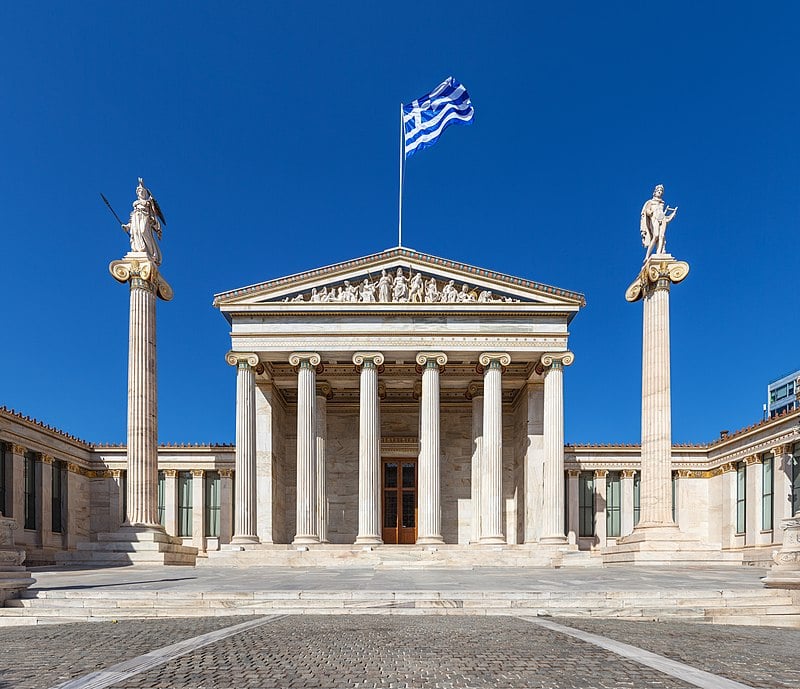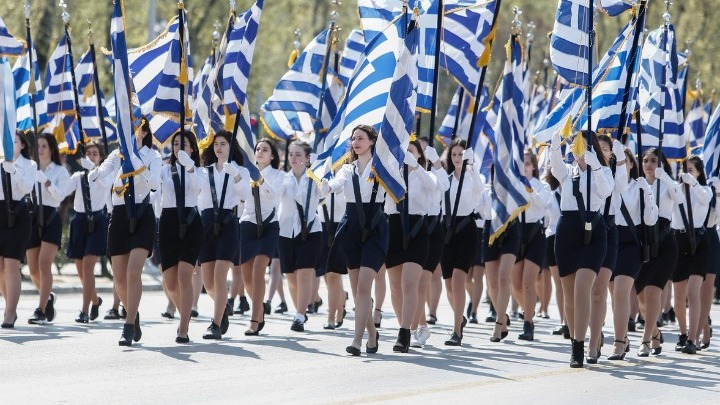Diglossia: When the Greek Language Was Barely Understood

Greek diglossia, which refers to the coexistence of two distinct varieties of the Greek language, has been a fascinating and uniquely Greek topic that culminated in the 20th century. It was nothing new, however, as it had been a defining feature of Greek society and culture for centuries. Today, we can say that it is actually an issue of the past.
However, there continue to be people in Greece who remember an era when the language they used in school was fundamentally different from the one spoken at home.
This genuinely peculiar and fascinating linguistic phenomenon involved two main elements that had far-reaching societal consequences, too. On one hand, there was a “high” formal variety of the Greek language, known as Katharevousa, and on the other, a “low” colloquial variety, called Demotic.
In the 19th and early 20th centuries, the tension between these two forms of Greek peaked. This was the moment when the broader struggle, which took place within Greek society over the form of its national identity, climaxed.
On one side of the argument, there were the proponents of a nostalgic Classical ideal who supported the full establishment of the archaizing Katharevousa version. On the other hand were those who championed the contemporary circumstances of the modern Greek people, represented by the vernacular Demotic Greek language.
The battle for the Greek language
The roots of this intriguing story of Greek diglossia can be traced back to Byzantine times. During these Eastern Roman times, an archaizing written language coexisted with the always evolving spoken dialects of the people across the empire.
However, it was in the early 1800s that the issue came to the forefront. As the Greeks fought for independence from Ottoman rule and shed their blood to establish a new national identity, the issue of their language was once again brought to the forefront. The only difference was that, this time, almost four centuries since the Greeks last formally had a state, their language had evolved significantly.
Adamantios Korais, a leading intellectual of the Greeks of the time, passionately advocated for the use of a “purified” form of Greek, which he called Katharevousa. Korais believed that this should have become the language of the newly formed Greek state.
Katharevousa, with its archaic grammar and vocabulary, was seen by Korais and his supporters as a direct way to connect modern Greece with its ancient past and assert its place among the civilized nations of Europe.
It has to be noted that the Katharevousa version of the Greek language was much closer to Koine Greek, the language that was spoken in the broader eastern Mediterranean two thousand years ago. Thus, throughout the 19th century, this form of language dominated the official spheres of the young Greek state, including government, law, and education.
Nonetheless, by the late 1800s, a new movement began to emerge much more fiercely. This social movement championed the officialization of the use of Demotic, the language of the people, in literature and public life alike. A key moment in this movement was the publication of Yannis Psycharis’ novel My Journey in 1888. This was written entirely in Demotic and argued for its use as the national language of Greece.
The Demotic movement gained momentum in the early 20th century, setting the stage for a showdown with the entrenched Katharevousa establishment.
As usual, this split took fundamentally political and partisan characteristics. Although not set in stone, it has to be said that the proponents of Katherevousa were the more conservative, right-wing parties. On the other hand, supporters of the Demotic, the language of the people, were the movements and parties on the left side of the Greek political spectrum of the time.

Differences between Demotic and Katharevousa
At the heart of the conflict between Demotic and Katharevousa supporters were fundamental differences in their linguistic nature and origins.
The Demotic version of the Greek language was the naturally evolved vernacular language of the Greek people, reflecting centuries of constant linguistic change and adaptation. It was the language of everyday life, of folk songs and oral traditions, and of the growing body of modern Greek literature, composed of thousands of works. This version of the language contained alterations to many aspects that had been part of the ancient Greek language. It also incorporated words from other ethnicities such as those of the Venetians and Ottomans.
Katharevousa, on the other hand, was not a language that had evolved organically from ancient Greece through the progression of time. It was, in fact, an artificial construct developed by scholars and language reformers in an attempt to “purify” the Greek language, rid it of its foreign elements, and restore it to its ancient glory.
Katharevousa was characterized by archaic grammatical forms, such as the use of ancient-style declensions, and a vocabulary heavily marked by learned neologisms and direct borrowings from ancient Greek. These had been lost in prior centuries.
Beyond these fundamental linguistic differences, Demotic and Katharevousa came to symbolize directly competing visions of the Greek identity and culture at their core. For supporters of Demotic, the vernacular language was seen as the authentic voice of the modern Greek people. It was the language of common people of the time and served as a vehicle for expressing their hopes, struggles, and aspirations untouched by political aims and artificial narratives.
Katharevousa, in contrast, was viewed by its opponents as a nostalgic symbol of a bygone era, an elitist language that was out of touch with the realities of contemporary Greek society. This was the reason that this purely linguistic matter obtained such crucial societal and political characteristics that divided Greek society for decades.
This ideological divide would have far-reaching consequences for education, politics, and social cohesion in Greece well into the mid to late 20th century.
Impact on education and society
The predominant role of Katharevousa in the educational system had profound consequences on Greek society, which lasted from the 19th all the way to the late 20th century. Schools in Greece exclusively taught in the archaic language. This meant that many children of lower-class backgrounds, who spoke only Demotic at home, were severely disadvantaged. The massive linguistic barrier made the education of the masses extremely difficult and perpetuated social inequalities.
Tensions between Demotic and Katharevousa supporters peaked in 1901 with the so-called “Gospel Riots,” which erupted in Athens. This incident was in response to the translation of the Gospels of the Orthodox Church into Demotic. The riots proved to be fatal for several people and left others injured. This highlighted deep social and political divisions within Greek society brought on by the fundamental issue of the nation’s spoken language.
The question of which version of the language would prevail in Greece also took on a clearly political dimension. This saw royalists and conservatives, in general, supporting Katharevousa, while liberals and the left favored the spoken language of the people, the Demotic. Such a clear alignment of linguistic preferences with political ideologies in Greece led to an even greater rift between the two camps.
Nonetheless, despite the official dominance of the Katharevousa in every official aspect of Greek society, the Demotic gradually gained traction in fields such as literature and journalism. This came to be in the early to mid-20th century with a clear shift to a more Demotic version of the language. Writers such as Alexandros Papadiamantis and Kostis Palamas chose to write in the vernacular. This helped establish Demotic as a truly legitimate literary language and paved the way for its eventual uniform acceptance.

The official Greek language today
The “Language Question,” as the debate over the use of the Demotic and Katharevousa versions of the Greek language came to be known, was finally and officially resolved in 1976. Less than two years after the restoration of democracy in Greece, Constantine Karamanlis’ government determined that the Demotic would become the official language of the people.
This was a truly significant milestone in the struggle for linguistic and cultural dominance in modern Greek society. Nonetheless, this bitter battle of diglossia has not entirely been laid to rest even to this day. This is particularly true as the Katharevousa version of the language continues to be used in certain formal and ceremonial contexts of Greek life, particularly within the Greek Orthodox Church.
Modern Greek, as it is spoken and written today, is practically a hybrid language. This is mainly because it incorporates elements of both Demotic and Katharevousa, which is the case with just about every language with the passage of time. The fusion reflects the rich history and evolution of the Greek language over centuries of cultural, social, and political change in times of turbulence and peace.
The case of Greek diglossia has also attracted much academic and scholarly interest, particularly in terms of language ideology and planning. Linguists and social scientists have examined the Greek diglossia question to better comprehend the ways in which language can both reflect and shape broader societal issues.
Lastly, we need to remember that the story of Greek diglossia is relevant even outside of the borders of Greece. There are a number of societies around the world, both past and present, that have faced the issue of linguistic duality and conflict.
From the coexistence of Latin and the vernacular languages in medieval Europe to the tensions between standard and non-standard varieties, such as in China’s contemporary society, the issues raised by Greek diglossia continue to be relevant to us all.
Business Wire







No comments